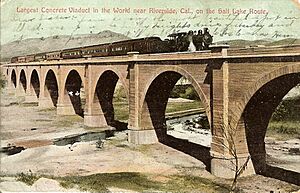Viaduct facts for kids
A viaduct is a special kind of bridge. It is made up of many smaller bridge sections, or "spans," connected together. Viaducts are built to cross wide areas like valleys, dry land, or wetlands. They can also help roads or railways go over other roads, which is called an overpass or flyover.

Contents
What is a Viaduct?
A viaduct is a long bridge that uses many short sections to cross a large space. Think of it as a series of small bridges joined together. This design helps them cross wide areas that might be difficult for a single, very long bridge.
Why Do We Build Viaducts?
People build viaducts for several important reasons:
- Crossing Valleys: They can carry roads or train tracks smoothly across deep valleys.
- Over Wetlands: Viaducts are perfect for going over wet or marshy land without disturbing the ground too much.
- Creating Overpasses: They allow one road or railway to pass over another, helping traffic flow better and preventing jams.
- Going Over Rivers: While many bridges cross rivers, viaducts are often used for very wide rivers or floodplains.
Where Does the Word "Viaduct" Come From?
The word viaduct has an interesting history. It comes from two Latin words:
- Via means "road."
- Ducere means "to lead."
So, a viaduct literally "leads a road." Even though the ancient Romans were amazing builders, they didn't use this word themselves. The word viaduct was actually created in the 1800s. It was made up by comparing it to the word aqueduct, which means "to lead water."
Images for kids
-
The 1812 Laigh Milton Viaduct in Ayrshire – the oldest surviving railway bridge in Scotland
-
Viaduct crossing the Santa Ana River in Riverside, California, built in 1903
-
The Glenfinnan Viaduct in the UK
-
"Deansgate Locks" bars under Deansgate Metrolink station in Manchester.
See also
 In Spanish: Viaducto para niños
In Spanish: Viaducto para niños






